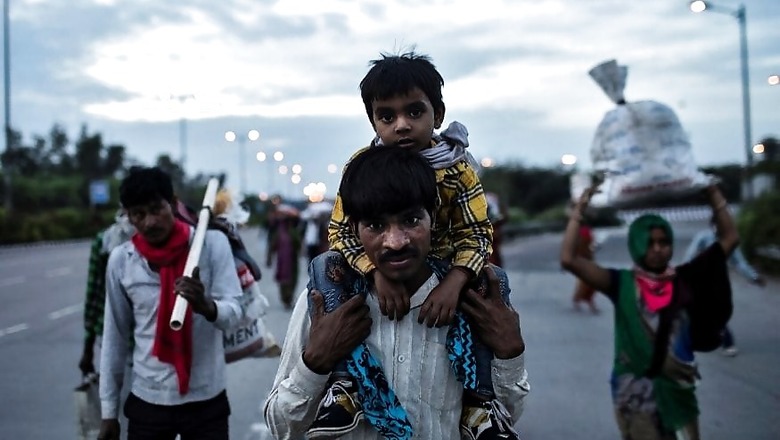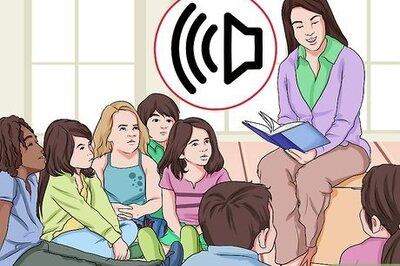
views
Jugyai: Most days, you can find Dayaram Kushwaha and his wife, Gyanvati, hauling bricks for stonemasons in a booming northern suburb of New Delhi. They bring their 5-year-old son, who plays in the dirt while they work.
But now a hush has come over the clattering construction site, silenced by India's nationwide order to shelter in place to prevent the spread of the novel coronavirus. Site managers no longer come to the intersection where Dayaram and many others stand, hoping to pick up work.
And so, with no way to feed his family or pay the rent, Dayaram hoisted his son Shivam onto his shoulders and began to walk to the village where he was born, 300 miles away.
He tried not to worry about what would happen once he got there, with empty pockets instead of the money he usually sent home to help support those left behind. At least he would have a home.
By dusk on the second day, Dayaram and around 50 others from his extended family had reached a deserted expressway running south out of the capital.
The family were hungry, thirsty and tired, and the police were never far away. Every time they stopped to rest, officers would shout at them to keep moving in single file, to maintain distance from one another to avoid spreading the virus. Officers are under orders to enforce the lockdown, but on that day they were allowing people to move.
Dayaram, 28, looked around. Thousands of other migrant workers were doing the same thing, in one of the biggest mass movements of people in the country since the partition of India and Pakistan in 1947.
It began to rain. Dayaram's thoughts turned to his other son, 7-year-old Mangal, who had been left behind in the village with elderly relatives because it was too hard to care for two children while he and his wife worked. He missed him.
In the middle of a pandemic, there was one consolation: "At least I will be with him."
PUSH AND PULL
For decades, villages across India have been emptying out.
To many people, the decision is one of simple arithmetic: to earn $6 per day instead of $3 back home. In areas like the parched Bundelkhand region of Madhya Pradesh state, home to Dayaram's ancestral village, living off the land has become increasingly difficult as rainfall recedes.
Others seek something more abstract: the prospect of escape that pulls anyone toward a big city.
But after the shutdown, the cities themselves began to empty. Dayaram and his family were among the first to move. As the days went on, and the situation became more desperate, hundreds of thousands of migrants emerged from factories and workplaces in search of a way home.
Indian officials say the shutdown is necessary to beat coronavirus in the densely populated country of 1.3 billion people, with a health infrastructure that can ill afford a widespread outbreak.
But for Dayaram and many of India's estimated 140 million migrant laborers, the epidemic is much more than a threat to their health – it endangers their very economic survival.
In the shutdown, India has banned domestic and international travel, and factories, schools, offices and all shops other than those supplying essential services have been shut. Taken together, the measures amount to one of the harshest lockdowns in the world.
Cases here have spiked to nearly 17,000, with more than 500 deaths. On April 14, the government extended the curbs until at least May 3, prompting clashes between police and migrants trying to leave India's financial capital, Mumbai.
Migrants are the backbone of the urban economy. Construction workers such as Dayaram are a necessity for India's rapidly expanding cities. Others clean toilets, drive taxis and deliver takeout. They predominantly earn daily wages, with no prospect of job security, and live in dirty, densely populated slums, saving money to send back home.
That money is essential to the young and elderly left behind in villages. Around $30 billion flows from urban to rural areas in India each year, according to government and academic estimates.
Now that infusion of money, transferred through rural banks or in worn stacks of rupees borne home on rare visits, has come to a halt.
TURN BACK TIME
The journey from New Delhi deep into rural India is one not just of distance, but of traveling back in time.
Skyscrapers and well-paved toll roads give way to fields of wheat and okra. Bare-backed men till the land with buffalo; an elderly shepherd herds his goats down a dusty lane.
After four days of walking and hitching lifts on a series of goods trucks, Dayaram, Gyanvati and Shivam reached their family's two-room concrete hut in Jugyai, a farming village of 2,000 people.
In a dingy room in the house filled with sacks of grain and clothes, an unframed poster hangs on the wall. It depicts a handsome red-roofed house on a lake, sun setting behind snow-capped mountains. A pair of mallard ducks fly overhead.
"I want to turn the clock back to when people lived in small villages and took care of each other," it says.
Though he can't read the English text on the poster, Dayaram agrees with the sentiment. He misses this village that can no longer sustain him.
"It's not that I love Delhi," he said. "I need the money to survive. If we had it, we would have stayed here. This is home."
His mother, 53-year-old Kesra, is more practical. She too had gone to New Delhi with her family, leaving the village behind.
"Home is wherever the family is," she said. "At least in Delhi there is money to buy food."
But now they are all back, and there is no money to buy food. Making it even worse, suspicion is never far away. The returnees must deal with new prejudice from villagers who used to be their friends.
"I am scared," said Sai Ram Lal, a neighbor who works in a soybean-oil factory here.
"It was spreading in Delhi, and I am worried that they have brought it here. We keep our distance. We don't interact with them like we used to before."
For Dayaram, that has left him an outsider in his own village.
"WE ARE LIKE GARBAGE"
The Bundelkhand region is famous for the towering 16th century sandstone temples and mausoleums of nearby Orchha. It has its own distinct culture, and young men still listen to high-tempo music in the local Bundeli language on their mobile phones.
The region used to get up to 35 inches of rain per year, according to the India Meteorological Department, but over the last decade, that has almost halved.
For many of the villagers, who have traditionally earned their living farming, it is a slow-motion disaster, forcing most able-bodied men and women to migrate in search of work.
It is early April, and even before the full onset of the fierce Indian summer, where temperatures climb toward 50 degrees Celsius, or 120 Fahrenheit, the air is already uncomfortably dry.
In a neighboring village where the majority of Dayaram's extended family lives, two dozen men stood idling by the road.
Only one, 62-year-old Lal Ram, has never been to Delhi. "I had some money, so I never went," he said with a shrug.
He's also the only one with a ration card, a sore point for those who migrated to Delhi. The Targeted Public Distribution Scheme allows India's poorest to purchase 5 kilograms of subsidized grains per month each. But because the migrant workers are no longer permanent residents, they're left without access to the food doled out from a nearby grain silo.
"Nobody listens to us," one of the men said bitterly. "We are like garbage."
Harshika Singh, the top government official in the district where both villages lie, didn't respond to requests for comment on the migrants' case.
Dayaram's father, 58-year-old Takur Das, was the first in the family to set off for New Delhi in search for work when it became increasingly difficult to make a living off the parched land.
That was a decade ago. Eventually, he sent for his son, too. The work there was hard, but it was steady.
"We can get some money for your wedding," he told Dayaram.
Many people in New Delhi would struggle to find Alipur, the Delhi suburb where they settled, on a map. It rarely makes the national news but for misfortune involving laborers: 25 children rescued by authorities in a series of warehouse raids; four men, including two brothers, crushed to death by sacks of rice.
Dayaram says his heart sank when he saw the crowded, tarpaulin-roofed slum where the family slept 12 to a room. His first thought was to run away back to the village.
But he stayed. What else could he do?
Dayaram talks continuously about fate. His marriage, his move to New Delhi, his flight back home – all were decisions made not out of choice, but necessity.
Dayaram's maternal aunt played matchmaker when it came time for him to marry. He and Gyanvati were from the same Kushwaha caste, from a lower rung of India's ancient social order who traditionally worked in agriculture.
They first met a month before their wedding day.
"She was OK," Dayaram said, a smile briefly crossing his face, remembering their meeting.
"But whatever is in my fate is fine, whether it is good or bad."
After Mangal was born, Gyanvati stayed behind in Jugyai to look after him. When he was 1½, she came to New Delhi with him, too.
But after Shivam was born, they were faced with a choice: take Mangal, too, or leave him in the village.
"It's easier to carry one child while working, but two is too difficult," Gyanvati said. "So we had to leave him behind."
NO ALTERNATIVE
The family's return this month coincided with harvest of the winter wheat crop. One morning, after a night on a rope-strung bed under the light of the pink supermoon, Dayaram put on a shirt ripped at the left armpit and headed to a nearby field.
His sons trailed behind, picking unripe berries from a bush. Shivam, wearing the same faded shirt in yellow checks as when he left New Delhi, put his hand on his elder brother's shoulder.
Dayaram, Gyanvati and three other relatives began cropping stalks by hand with well-worn scythes. After three days there, harvesting almost a ton of wheat, they received no payment – just 50 kilograms of the crop to take to the village flour mill.
The family's basket of lumpen potatoes would last a week. When that ran out, they would have to survive on bread alone.
In good months in New Delhi, they were able to save 8,000 rupees, or about $100, a month to send back home, and to repay a loan taken out when Gyanvati fell sick early in their marriage.
But soon, Dayaram said, he would be forced to borrow again from local money lenders, charging interest at 3% a month – a rate that can quickly spiral into unpayable debts.
Despite being separated for months at a time, Mangal and Shivam are still close. Both have their father's broad nose and mother's lively eyes, the same matching bowl haircuts with unevenly shorn sides.
"They cut each other's hair," said Gyanvati, laughing. "That's why they look like that."
Both boys shrugged when asked if they wanted to go school, as if the issue had never really been discussed.
Dayaram worries that the shutdown will end any hope of providing his children with an education.
"No parent wants their child to work as a laborer," he said. But there is no alternative, he said: "They will have to do what I have done."
Beneath the brilliant red blossoms of the Indian coral tree, the family finished the field on the stroke of midday, a white sun directly overhead.
Mangal and Shivam were tired from chasing dragonflies through the freshly cropped stubble, and sat quietly watching cartoons on a mobile phone. Dayaram came over to where they were sitting. He wiped the sweat from his brow, looked at his boys and smiled.




















Comments
0 comment